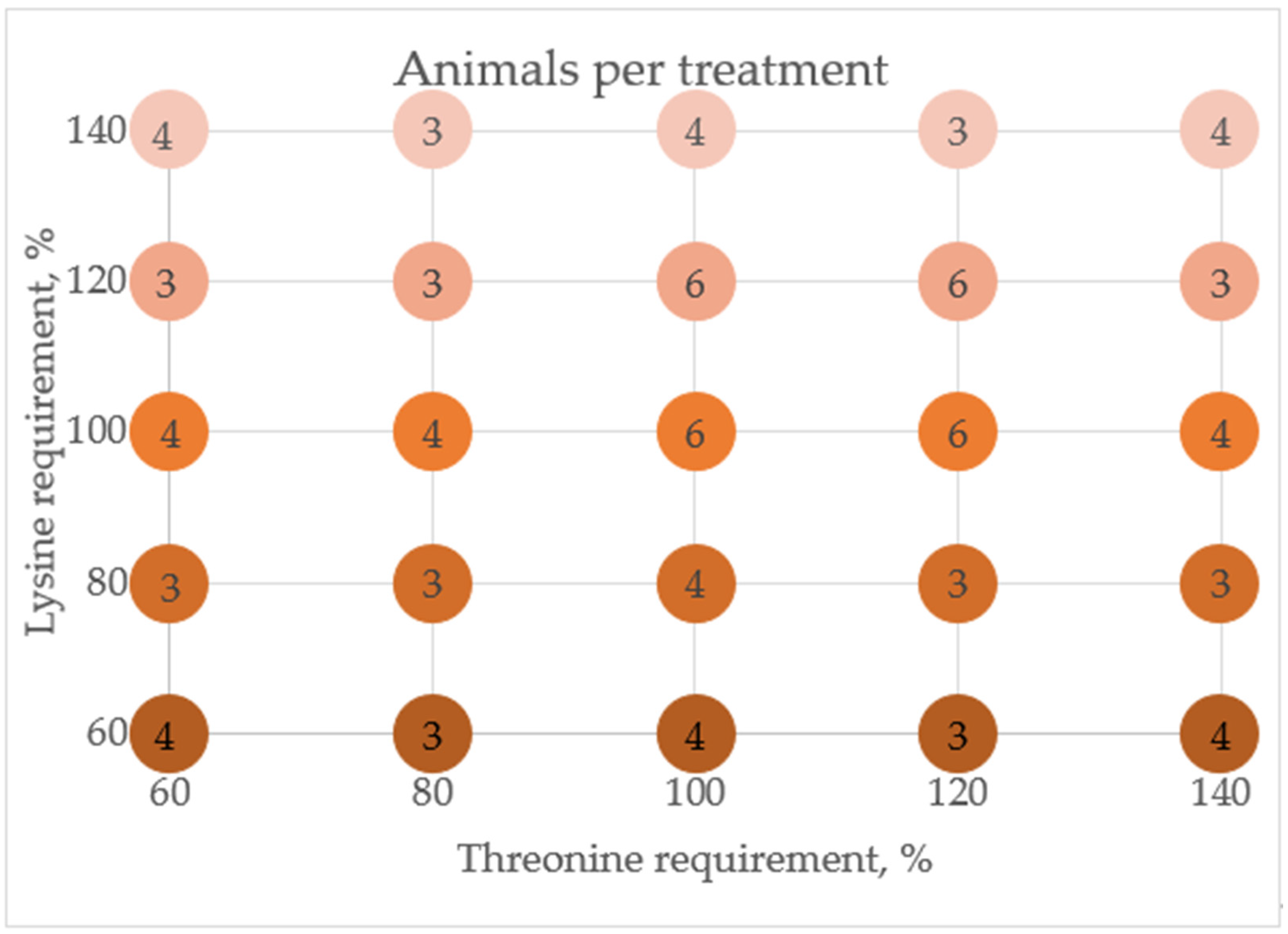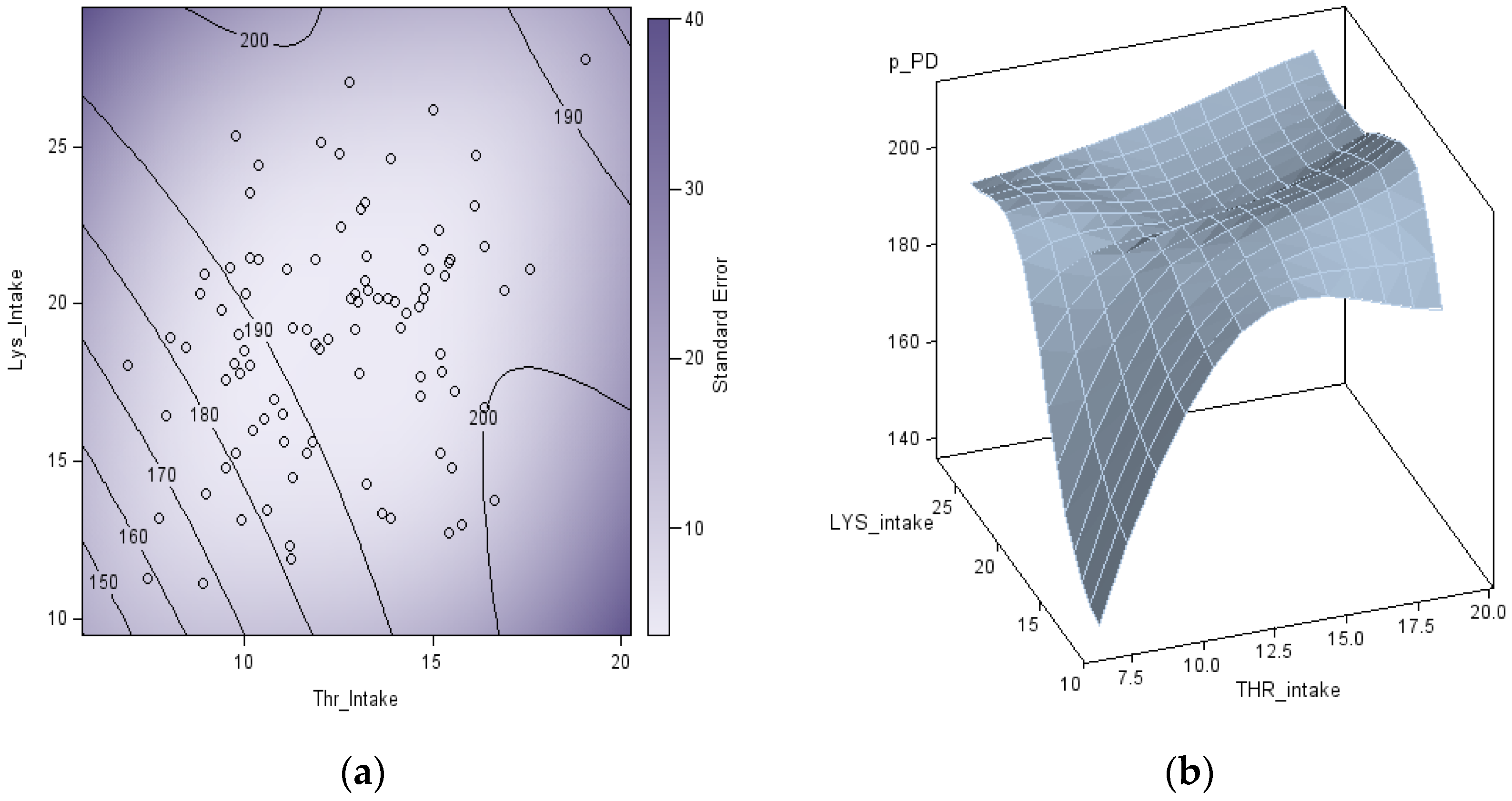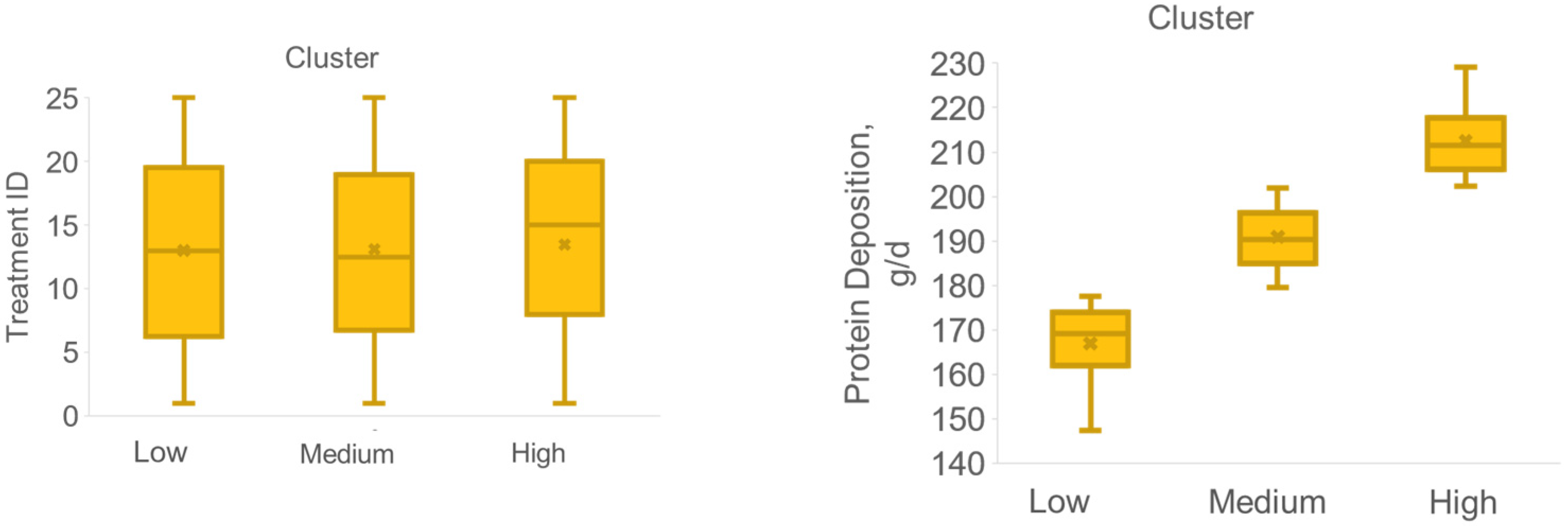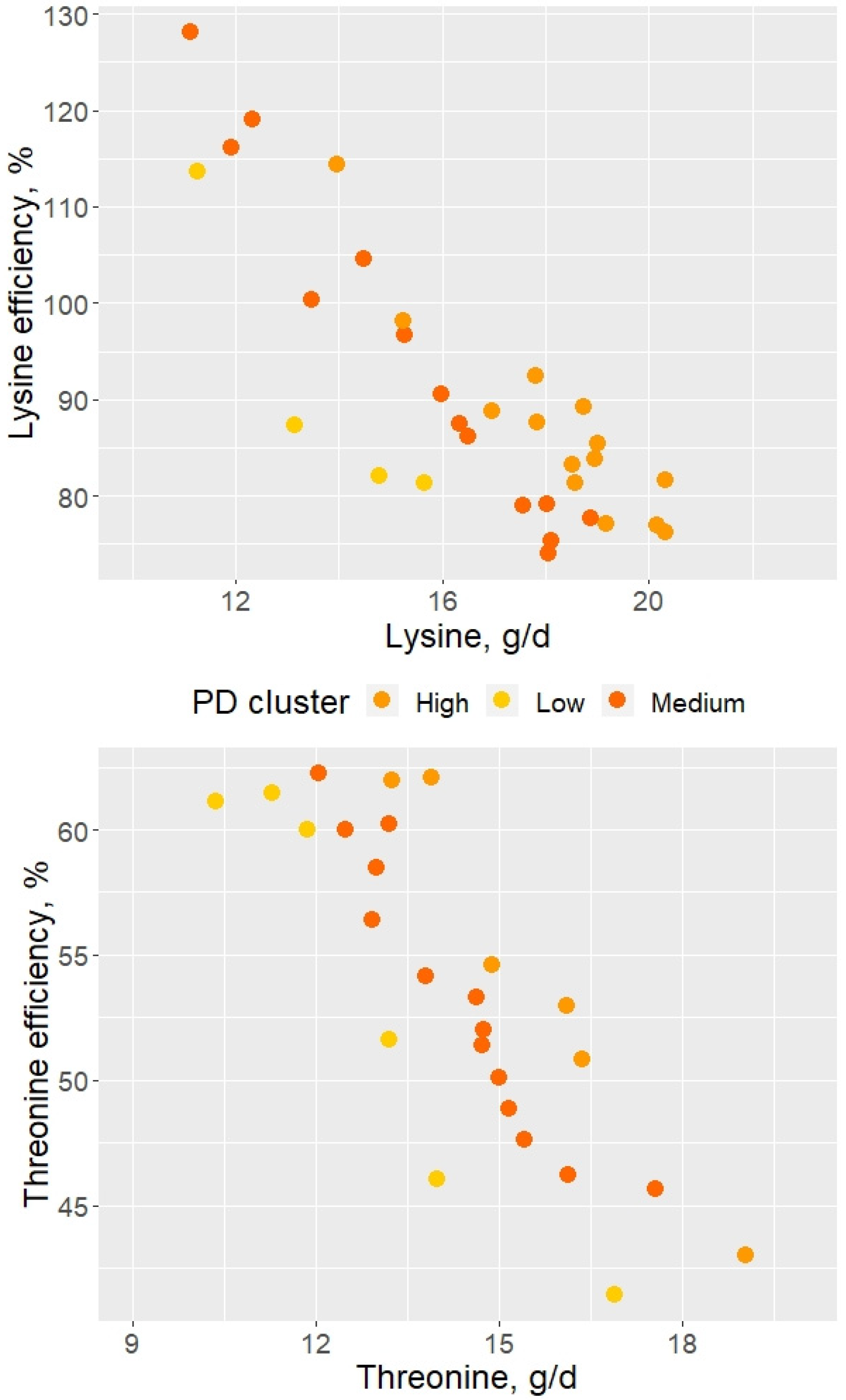Estimating Amino Acid Requirements in Real-Time for Precision-Fed Pigs: The Challenge of Variability among Individuals
Abstract
Simple Summary
Abstract
1. Introduction
2. Materials and Methods
2.1. Nutritional Requirements and Diets
2.2. Experimental Measurements
2.2.1. Animal Performance, Nutrient Efficiency, and Carcass Evaluation
2.2.2. Blood Sample Collection and Slaughter
2.2.3. Chemical and Biochemical Analysis
2.3. Calculations
2.4. Statistical Analysis
3. Results and Discussion
3.1. The Simultaneous Determination of Two AA Requirements
3.2. Differences in PD
3.3. Differences in the Estimated Lysine and Threonine Efficiency of Utilization
4. Conclusions
Author Contributions
Funding
Institutional Review Board Statement
Data Availability Statement
Acknowledgments
Conflicts of Interest
References
- National Research Council. Nutrient Requirements of Swine: Eleventh Revised Edition, 12th ed.; The National Academies Press: Washington, DC, USA, 2012; p. 420. [Google Scholar]
- Rostagno, H.S.; Albino, L.F.T.; Hannas, M.I.; Donzele, J.L.; Sakomura, N.K.; Perazzo, F.G.; Saraiva, A.; Teixeira, M.L.; Rodrigues, P.B.; Oliveira, R.F.; et al. Brazilian Tables for Poultry and Swine: Composition of Feedstuffs and Nutritional Requirements, 4th ed.; UFV: Viçosa, Brazil, 2017; p. 488. [Google Scholar]
- Mahan, D.; Shields, R. Essential and nonessential amino acid composition of pigs from birth to 145 kg of body weight, and comparison to other studies. J. Anim. Sci. 1998, 76, 513–521. [Google Scholar] [CrossRef]
- Möhn, S.; Gillis, A.; Moughan, P.; de Lange, C. Influence of dietary lysine and energy intakes on body protein deposition and lysine utilization in the growing pig. J. Anim. Sci. 2000, 78, 1510–1519. [Google Scholar] [CrossRef]
- De Lange, C.; Gillis, A.; Simpson, G. Influence of threonine intake on whole-body protein deposition and threonine utilization in growing pigs fed purified diets. J. Anim. Sci. 2001, 79, 3087–3095. [Google Scholar] [CrossRef]
- van Milgen, J.; Valancogne, A.; Dubois, S.; Dourmad, J.-Y.; Sève, B.; Noblet, J. InraPorc: A model and decision support tool for the nutrition of growing pigs. Anim. Feed Sci. Technol. 2008, 143, 387–405. [Google Scholar] [CrossRef]
- Noblet, J.; Sève, B.; Jondreville, C. Valeurs Nutritives pour les Porcs; INRA: Paris, France, 2002. [Google Scholar]
- Moughan, P. Protein metabolism in the growing pig. In A Quantitative Biology of the Pig; CABI Publishing: Wallingford, UK, 1999; pp. 299–331. [Google Scholar]
- Le Bellego, L.; Noblet, J. Performance and utilization of dietary energy and amino acids in piglets fed low protein diets. Livest. Prod. Sci. 2002, 76, 45–58. [Google Scholar] [CrossRef]
- van Milgen, J.; Dourmad, J.-Y. Concept and application of ideal protein for pigs. J. Anim. Sci. Biotechnol. 2015, 6, 1. [Google Scholar] [CrossRef]
- Remus, A.; Hauschild, L.; Corrent, E.; Létourneau-Montminy, M.-P.; Pomar, C. Pigs receiving daily tailored diets using precision-feeding techniques have different threonine requirements than pigs fed in conventional phase-feeding systems. J. Anim. Sci. Biotechnol. 2019, 10, 16. [Google Scholar] [CrossRef]
- AOAC. Official Methods of the Association of Official Analytical Chemists (AOAC); Virginia—Association of Official Analytical Chemists: Rockville, MD, USA, 1990. [Google Scholar]
- Calder, A.; Garden, K.; Anderson, S.; Lobley, G. Quantitation of blood and plasma amino acids using isotope dilution electron impact gas chromatography/mass spectrometry with U-13C amino acids as internal standards. Rapid Commun. Mass Spectrom. 1999, 13, 2080–2083. [Google Scholar] [CrossRef]
- Pomar, C.; Rivest, J. The effect of body position and data analysis on the estimation of body composition of pigs by dual energy X-ray absorptiometry (DEXA). In Proceedings of the 46th Annual Conference of the Canadian Society of Animal Science, Lethbridge, AB, Canada, 7–11 July 1996. [Google Scholar]
- Bates, D.; Mächler, M.; Bolker, B.; Walker, S. Fitting linear mixed-effects models using lme4. arXiv 2014, arXiv:1406.5823. [Google Scholar]
- Lüdecke, D.; Ben-Shachar, M.S.; Patil, I.; Waggoner, P.; Makowski, D. Performance: An R package for assessment, comparison and testing of statistical models. J. Open Source Softw. 2021, 6. [Google Scholar] [CrossRef]
- Nakagawa, S.; Johnson, P.C.; Schielzeth, H. The coefficient of determination R 2 and intra-class correlation coefficient from generalized linear mixed-effects models revisited and expanded. J. R. Soc. Interface 2017, 14, 20170213. [Google Scholar] [CrossRef]
- Gloaguen, M.; Le Floc’H, N.; Brossard, L.; Barea, R.; Primot, Y.; Corrent, E.; van Milgen, J. Response of piglets to the valine content in diet in combination with the supply of other branched-chain amino acids. Animal 2011, 5, 1734–1742. [Google Scholar] [CrossRef]
- Soto, J.A.; Tokach, M.D.; Dritz, S.S.; Woodworth, J.C.; DeRouchey, J.M.; Goodband, R.D.; Wu, F. Optimal dietary standardized ileal digestible lysine and crude protein concentration for growth and carcass performance in finishing pigs weighing greater than 100 kg. J. Anim. Sci. 2019, 97, 1701–1711. [Google Scholar] [CrossRef]
- D’Mello, J.P.F.; Lewis, D. Amino acid interactions in chick nutrition. Br. Poult. Sci. 1970, 11, 367–385. [Google Scholar] [CrossRef]
- Fallah, H.; Karimi, A.; Sadeghi, A.; Behroozi-Khazaei, N. Modelling and optimizing of calcium and non-phytate phosphorus requirements of male broiler chickens from 1 to 21 days of age using response surface methodology. Animal 2020, 14, 1598–1609. [Google Scholar] [CrossRef]
- Remus, A.; Hauschild, L.; Létourneau-Montminy, M.-P.; Corrent, E.; Pomar, C. The ideal protein profile for late-finishing pigs in precision feeding systems: Threonine. Anim. Feed Sci. Technol. 2020, 265, 114500. [Google Scholar] [CrossRef]
- Mnilk, B.; Harris, C.I.; Fuller, M.F. Lysine utilization by growing pigs: Simultaneous measurement of protein accretion and lysine oxidation. Br. J. Nutr. 1996, 75, 57–67. [Google Scholar] [CrossRef][Green Version]
- Moughan, P. Simulation of the daily partitioning of lysine in the 50 kg liveweight pig-A factorial approach to estimating amino acid requirements for growth and maintenance. Res. Dev. Agric. 1989, 6, 7–14. [Google Scholar]
- Moehn, S.; Ball, R.O.; Fuller, M.F.; Gillis, A.M.; de Lange, C.F.M. Growth Potential, but Not Body Weight or Moderate Limitation of Lysine Intake, Affects Inevitable Lysine Catabolism in Growing Pigs. J. Nutr. 2004, 134, 2287–2292. [Google Scholar] [CrossRef]
- Bertolo, R.F.; Pencharz, P.B.; Ball, R.O. Organ and plasma amino acid concentrations are profoundly different in piglets fed identical diets via gastric, central venous or portal venous routes. J. Nutr. 2000, 130, 1261–1266. [Google Scholar] [CrossRef]
- Lewis, A. Methionine-cystine relationships in pig nutrition. In Amino Acids Animal Nutrition (Ed. JPF D’Mello); CABI Publishing: Wallingford, UK, 2003; pp. 143–155. [Google Scholar]
- Cota, D.; Proulx, K.; Smith, K.A.B.; Kozma, S.C.; Thomas, G.; Woods, S.C.; Seeley, R.J. Hypothalamic mTOR signaling regulates food intake. Science 2006, 312, 927–930. [Google Scholar] [CrossRef]
- Henry, Y.; Sève, B.; Colléaux, Y.; Ganier, P.; Saligaut, C.; Jégo, P. Interactive effects of dietary levels of tryptophan and protein on voluntary feed intake and growth performance in pigs, in relation to plasma free amino acids and hypothalamic serotonin. J. Anim. Sci. 1992, 70, 1873–1887. [Google Scholar] [CrossRef]
- Millet, S.; Aluwé, M.; Ampe, B.; De Campeneere, S. Interaction between amino acids on the performances of individually housed piglets. J. Anim. Physiol. Anim. Nutr. 2015, 99, 230–236. [Google Scholar] [CrossRef]
- Morales, A.; Arce, N.; Cota, M.; Buenabad, L.; Avelar, E.; Htoo, J.K.; Cervantes, M. Effect of dietary excess of branched-chain amino acids on performance and serum concentrations of amino acids in growing pigs. J. Anim. Physiol. Anim. Nutr. 2016, 100, 39–45. [Google Scholar] [CrossRef]
- Langer, S.; Fuller, M.F. Interactions among the branched-chain amino acids and their effects on methionine utilization in growing pigs: Effects on nitrogen retention and amino acid utilization. Br. J. Nutr. 2000, 83, 43–48. [Google Scholar] [CrossRef]
- Langer, S.; Scislowski, P.W.D.; Brown, D.S.; Dewey, P.; Fuller, M.F. Interactions among the branched-chain amino acids and their effects on methionine utilization in growing pigs: Effects on plasma amino– and keto–acid concentrations and branched-chain keto-acid dehydrogenase activity. Br. J. Nutr. 2000, 83, 49–58. [Google Scholar] [CrossRef]
- Yoshida, A.; Leung, P.M.-B.; Rogers, Q.R.; Harper, A.E. Effect of Amino Acid Imbalance on the Fate of the Limiting Amino Acid. J. Nutr. 1966, 89, 80–90. [Google Scholar] [CrossRef]
- Benevenga, N.; Harper, A.; Rogers, Q. Effect of an amino acid imbalance on the metabolism of the most-limiting amino acid in the rat. J. Nutr. 1968, 95, 434–444. [Google Scholar] [CrossRef]
- Swick, R.W. Measurement of protein turnover in rat liver. J. Biol. Chem. 1958, 231, 751–764. [Google Scholar] [CrossRef]
- Koehn, R.K.; Bayne, B.L. Towards a physiological and genetical understanding of the energetics of the stress response. Biol. J. Linn. Soc. 1989, 37, 157–171. [Google Scholar] [CrossRef]
- Hawkins, A.J.S. Protein Turnover: A Functional Appraisal. Funct. Ecol. 1991, 5, 222–233. [Google Scholar] [CrossRef]
- Salter, D.; Montgomery, A.; Hudson, A.; Quelch, D.; Elliott, R.J. Lysine requirements and whole-body protein turnover in growing pigs. Br. J. Nutr. 1990, 63, 503–513. [Google Scholar] [CrossRef]
- Remus, A.; van Milgen, J.; Pomar, C. Precision feeding optimises efficiency of protein utilisation in pigs. In Proceedings of the 71st Annual Meeting of the European Federation of Animal Science (EAAP), Porto, Portugal, 31 August–4 September 2020. [Google Scholar]
- Remus, A.; Méthot, S.; Hauschild, L.; Létourneau-Montminy, M.P.; Pomar, C. Estimating real time individual lysine and threonine requirements in precision-fed pigs. In Energy and Protein Metabolism and Nutrition; Wageningen Academic Publishers: Wageningen, The Netherlands, 2019; pp. 451–452. [Google Scholar]
- Remus, A. The Ideal Protein Profile for Growing-Finishing Pigs in Precision Feeding Systems: Threonine. Dual Doctoral Program; Université Laval: Québec, QC, Canada, 2018. [Google Scholar]
- Communications Branch Agriculture Canada. Recommended Code of Practice for the Care and Handling of Farm Animals; Communications Branch Agriculture Canada: Ottawa, ON, Canada, 2012. [Google Scholar]
- Canadian Council on Animal Care. CCAC Guidelines on: The Care and Use of Farm Animals in Research, Teaching and Testing; CCAC: Ottawa, ON, Canada, 2009. [Google Scholar]




| Item | A1 | A2 | A3 | A4 |
|---|---|---|---|---|
| Ingredient (%) | ||||
| Corn | 39.81 | 32.35 | 38.52 | 40.42 |
| Wheat | 30.00 | 30.00 | 30.00 | 30.00 |
| Canola meal | 14.00 | 14.00 | 14.00 | 14.00 |
| Soybean meal | 6.20 | 12.50 | 6.10 | 6.10 |
| Soybean oil | 3.50 | 3.90 | 3.50 | 3.50 |
| Limestone | 1.30 | 1.28 | 1.29 | 1.30 |
| Monocalcium phosphate | 0.37 | 0.32 | 0.38 | 0.37 |
| Vitamin-mineral premix 1 | 0.20 | 0.20 | 0.20 | 0.20 |
| Salt | 0.53 | 0.53 | 0.53 | 0.53 |
| L-threonine | 0.50 | 0.44 | 0.00 | 0.00 |
| L-lysine HCL | 0.00 | 1.26 | 1.55 | 0.00 |
| DL-methionine | 0.29 | 0.28 | 0.34 | 0.29 |
| L-tryptophan | 0.09 | 0.12 | 0.16 | 0.09 |
| L-valine | 0.34 | 0.29 | 0.41 | 0.34 |
| L-isoleucine | 0.29 | 0.15 | 0.26 | 0.26 |
| L-leucine | 0.39 | 0.23 | 0.39 | 0.39 |
| L-histidine | 0.15 | 0.04 | 0.11 | 0.15 |
| L-phenylalanine | 0.00 | 0.05 | 0.17 | 0.00 |
| L-arginine | 0.00 | 0.00 | 0.03 | 0.00 |
| Chemical composition (%) | ||||
| Dry matter 2 | 87.27 | 87.51 | 87.40 | 87.21 |
| Crude protein 2 | 15.48 | 19.00 | 16.40 | 15.10 |
| Net energy 3 (MJ/kg) | 10.25 | 10.25 | 10.25 | 10.24 |
| Crude fiber 3 | 3.62 | 3.62 | 3.58 | 3.63 |
| Calcium 3 | 0.70 | 0.70 | 0.70 | 0.70 |
| Digestible phosphorus 3 | 0.31 | 0.31 | 0.31 | 0.31 |
| Analyzed SID AA 4 (%), as-fed basis | ||||
| Arginine | 0.76 | 0.95 | 0.78 | 0.76 |
| Histidine | 0.48 | 0.43 | 0.43 | 0.48 |
| Isoleucine | 0.73 | 0.73 | 0.73 | 0.73 |
| Leucine | 1.41 | 1.41 | 1.41 | 1.41 |
| Lysine | 0.54 | 1.40 | 1.40 | 0.54 |
| Methionine | 0.52 | 0.54 | 0.57 | 0.64 |
| Methionine + cysteine | 0.79 | 0.84 | 0.84 | 0.88 |
| Phenylalanine | 0.60 | 0.76 | 0.76 | 0.57 |
| Threonine | 0.94 | 0.97 | 0.44 | 0.44 |
| Tryptophan 3 | 0.24 | 0.31 | 0.31 | 0.24 |
| Valine | 0.91 | 0.98 | 0.98 | 0.91 |
| Item | Low PD | Medium PD | High PD | MSE 1 | p-Value |
|---|---|---|---|---|---|
| Number of observations | 16 | 38 | 37 | ||
| Initial body conditions | |||||
| Body weight, kg | 35.8 | 34.5 | 34.7 | 2.11 | 0.14 |
| Lipids, g | 1793 | 1698 | 1684 | 195 | 0.17 |
| Protein, g | 7225 | 6966 | 6999 | 422 | 0.11 |
| Body protein, % | 20.2 | 20.2 | 20.2 | 0.19 | 0.85 |
| Backfat thickness, cm | 6.5 | 6.2 | 6.3 | 0.82 | 0.56 |
| Loin depth, cm | 35.9 | 37.0 | 36.4 | 2.66 | 0.36 |
| Growth performance 2 | |||||
| ADFI, kg | 1.93 | 1.91 | 1.89 | 0.06 | 0.83 |
| ADG, kg | 0.97 a | 1.06 b | 1.16 c | 0.06 | <0.0001 |
| Gain:feed | 0.51 a | 0.56 b | 0.62 c | 0.06 | <0.0001 |
| PD, g/d | 167 a | 191 b | 213 c | 7.42 | <0.0001 |
| Lipid deposition, g/d | 171 | 160 | 166 | 42.62 | 0.64 |
| PD in the ADG, % | 17.3 a | 18.0 ab | 18.3 b | 0.90 | 0.00 |
| Nitrogen retained, % | 50 a | 57 b | 64 c | 7.42 | <0.0001 |
| Thr 3 efficiency, % | 59.0 a | 64.3 ab | 69.9 b | 14.91 | 0.05 |
| Lys 3 efficiency, % | 70.2 a | 74.0 ab | 80.8 b | 14.51 | 0.04 |
| Loin deposition, mm | 12 | 11 | 13 | 3.32 | 0.30 |
| Backfat deposition, mm | 2.0 | 2.7 | 2.5 | 1.08 | 0.10 |
| Number of meals per day | 12 | 11 | 11 | 2.86 | 0.57 |
| Final body conditions | |||||
| BW, Kg | 56.0 a | 56.8 a | 59.1 b | 2.8 | <0.001 |
| Lipids, g | 5391.9 | 5054.4 | 5160.0 | 258.1 | 0.55 |
| Protein, g | 10,730 a | 10,976 a | 11,462 b | 105.0 | <0.0001 |
| Backfat thickness, cm | 8.41 | 9.07 | 8.86 | 0.34 | 0.27 |
| Loin depth, cm | 48.3 | 48.3 | 49.0 | 1.04 | 0.72 |
| Longissimus dorsi muscle * | |||||
| Crude protein, % | 22.69 a | 22.46 ab | 22.41 b | 0.10 | 0.08 |
| Lipids, % | 1.49 | 1.36 | 1.44 | 0.12 | 0.64 |
| Collagen, % | 1.28 | 1.25 | 1.29 | 0.03 | 0.37 |
| Lys, g/100 g of CP | 9.2 | 9.3 | 9.5 | 0.51 | 0.42 |
| Thr, g/100 g of CP | 4.5 | 4.6 | 4.6 | 0.06 | 0.56 |
| Item | Low PD | Medium PD | High PD | MSE 1 | p-Value |
|---|---|---|---|---|---|
| Number of observations | 16 | 38 | 37 | ||
| Crude protein, g/d | 337.6 | 336.7 | 336.3 | 10.15 | 0.99 |
| Lys, g/d | 17.8 | 18.7 | 19.6 | 3.73 | 0.24 |
| Thr, g/d | 12.0 | 12.4 | 12.9 | 2.61 | 0.48 |
| Methionine, g/d | 11.1 | 10.8 | 10.6 | 0.39 | 0.53 |
| Tryptophan, g/d | 5.4 | 5.5 | 5.5 | 0.17 | 0.88 |
| Valine, g/d | 17.0 | 17.0 | 16.9 | 2.10 | 0.97 |
| Leucine, g/d | 24.0 | 24.2 | 24.3 | 2.91 | 0.93 |
| Isoleucine, g/d | 13.3 | 13.2 | 13.1 | 1.67 | 0.90 |
| Phenylalanine, g/d | 12.9 | 13.0 | 13.1 | 0.40 | 0.94 |
| Feed A, % | 11.2 | 11.8 | 9.6 | 4.77 | 0.88 |
| Feed B, % | 33.1 | 39.3 | 48.1 | 7.71 | 0.22 |
| Feed C, % | 26.5 | 28.5 | 28.1 | 6.6 | 0.97 |
| Feed D, % | 29.2 a | 20.4 ab | 14.2 b | 4.6 | 0.03 |
| Item | Low | Medium | High | MSE 1 | p-Value |
|---|---|---|---|---|---|
| Number of observation | 16 | 38 | 37 | ||
| Lysine | 144.0 a | 166.9 ab | 169.9 b | 10.3 | 0.10 |
| Threonine | 139.5 | 149.6 | 159.7 | 11.3 | 0.31 |
| Methionine | 35.4 | 36.3 | 37.8 | 2.1 | 0.60 |
| Tryptophan | 54.5 | 58.8 | 55.0 | 2.2 | 0.12 |
| Valine | 343.7 a | 374.4 b | 358.2 ab | 9.9 | 0.03 |
| Leucine | 183.5 | 199.3 | 189.6 | 7.1 | 0.13 |
| Isoleucine | 110.6 a | 121.2 b | 115.4 ab | 4.2 | 0.08 |
| Phenylalanine | 69.8 | 68.3 | 66.4 | 2.7 | 0.55 |
| Glycine | 867.7 a | 971.5 b | 976.6 b | 37.1 | 0.04 |
| Serine | 91.5 | 98.3 | 95.3 | 3.2 | 0.19 |
| Cysteine | 227.2 | 234.4 | 231.1 | 4.0 | 0.29 |
| Alanine | 274.8 | 275.5 | 253.5 | 16.8 | 0.32 |
| Arginine | 147.4 ab | 160.8 a | 145.8 b | 6.6 | 0.04 |
| Asparagine | 31.0 | 33.2 | 31.9 | 1.0 | 0.14 |
| Aspartic acid | 7.1 | 7.3 | 7.2 | 0.5 | 0.94 |
| Glutamate | 110.2 | 111.0 | 103.4 | 8.5 | 0.60 |
| Glutamine | 421.8 | 439.9 | 458.0 | 15.0 | 0.12 |
| Homocysteine | 26.1 a | 28.7 ab | 31.1 b | 1.2 | 26.1 |
| Proline | 168.54 | 172.46 | 178.28 | 5.08 | 0.23 |
| Tyrosine | 69.98 | 73.08 | 71.96 | 2.90 | 0.67 |
| Lysine Efficiency | Threonine Efficiency | |||
|---|---|---|---|---|
| Item | Model 1 (SE) | Model 2 (SE) | Model 3 (SE) | Model 4 (SE) |
| Intercept | 188.729 (8.081) ** | 274.589 (23.862) ** | 102.400 (3.720) ** | 127.548 (15.673) ** |
| Linear slope-Lys intake | −6.183 (0.366) ** | −17.505 (3.020) ** | ||
| Quadratic slope-Lys intake | 0.362 (0.096) ** | |||
| Linear slope-Thr intake | −3.405 (0.206) ** | −6.897 (2.129) ** | ||
| Quadratic slope-Thr intake | 0.119 (0.072) * | |||
| AIC 1 | 204.583 | 194.975 | 124.45 | 123.93 |
| BIC | 210.446 | 202.304 | 129.482 | 130.22 |
| Num. observations | 32 | 32 | 26 | 26 |
| Num. groups: cluster | 3 | 3 | 3 | 3 |
| Variance cluster (random intercept) | 92.256 | 85.163 | 14.97 | 16.369 |
| Variance residual | 19.042 | 12.876 | 3.413 | 3.025 |
| R2 conditional (fixed and random effect) | 0.95 | 0.97 | 0.95 | 0.96 |
| R2 marginal (fixed effect) | 0.72 | 0.74 | 0.72 | 0.71 |
| RMSE | 4.16 | 3.42 | 1.74 | 1.64 |
| ICC | 0.83 | 0.87 | 0.81 | 0.84 |
Publisher’s Note: MDPI stays neutral with regard to jurisdictional claims in published maps and institutional affiliations. |
© 2021 by the authors. Licensee MDPI, Basel, Switzerland. This article is an open access article distributed under the terms and conditions of the Creative Commons Attribution (CC BY) license (https://creativecommons.org/licenses/by/4.0/).
Share and Cite
Remus, A.; Hauschild, L.; Létourneau-Montminy, M.-P.; Pomar, C. Estimating Amino Acid Requirements in Real-Time for Precision-Fed Pigs: The Challenge of Variability among Individuals. Animals 2021, 11, 3354. https://doi.org/10.3390/ani11123354
Remus A, Hauschild L, Létourneau-Montminy M-P, Pomar C. Estimating Amino Acid Requirements in Real-Time for Precision-Fed Pigs: The Challenge of Variability among Individuals. Animals. 2021; 11(12):3354. https://doi.org/10.3390/ani11123354
Chicago/Turabian StyleRemus, Aline, Luciano Hauschild, Marie-Pierre Létourneau-Montminy, and Candido Pomar. 2021. "Estimating Amino Acid Requirements in Real-Time for Precision-Fed Pigs: The Challenge of Variability among Individuals" Animals 11, no. 12: 3354. https://doi.org/10.3390/ani11123354
APA StyleRemus, A., Hauschild, L., Létourneau-Montminy, M.-P., & Pomar, C. (2021). Estimating Amino Acid Requirements in Real-Time for Precision-Fed Pigs: The Challenge of Variability among Individuals. Animals, 11(12), 3354. https://doi.org/10.3390/ani11123354






